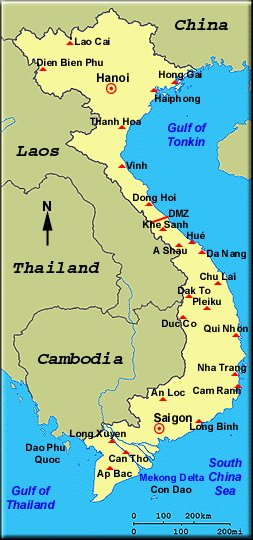
|
|
"Vietnam...We've all been there."
--Michael Herr, Dispatches
"Vietnam is still with us. It has created doubts about
American judgment, about American credibility, about American power--not only
at home, but throughout the world. It has poisoned our domestic debate. So
we paid an exorbitant price for the decisions that were made in good faith
and for good purpose."
--Henry Kissinger in Stanley Karnow's Vietnam: A History
"I served. I came back. I will never forget those who did not. The faces of the men I knew are as clear to me as if it was only yesterday. Those who served are all brothers and only they can ever know what it was really like."
![]()
|
For much of Vietnam's history it has been under foreign rule, primarily
by the Chinese.
Between 1955 and 1960, the North Vietnamese with the assistance of the southern communist Vietcong, tried to take over the government in South Vietnam, and in November 1963 President Diem was overthrown and executed. The following year, the North Vietnamese began a massive drive to conquer the whole country aided by China and Russia. |

|
Fearing a communist takeover of the entire region, the
United States grew more and more wary of the progress of Ho Chi Minh
and the Vietcong. Communism had become the evil menace in the United
States and with expansion of Soviet rule into Eastern Europe, Korea
and Cuba, the Americans were bent on stopping communism from spreading
any further.
With the cold war at its height, the US leaders were worried that an attack on North Vietnam by the US would create tensions with the Chinese and Russians that would, in turn, lead to a larger conflict and possibly WW III. This created a difficult situation for the US and would eventually lead to many internal conflicts, which ultimately prevented the US from forming a firm policy for the region. The US was also faced with a number of cultural differences between the two countries, and what was considered corrupt by the US government was considered legitimate by South Vietnamese standards. It was difficult for the US to portray South Vietnam as a hard working, hard fighting democracy; corruption was widespread among officials and the armed forces. The Army of the Republic of Vietnam (ARVN) was disorganized due to the low morale of it's leaders and their singular interest in personal gain. Therefore the US had a great deal of difficulty in holding the army together in South Vietnam and saw only one solution, that was to start taking care of things for themselves. By 1950 the US began sending their first troops, firstly in an advisory role, which slowly escalated into a full blown commitment. The large-scale involvement of the US came under the tenure of President
Lyndon B. Johnson and his Gulf of Tonkin Resolution. Johnson had replaced
John F. Kennedy after he was assassinated in Dallas, Texas 1963. As
president, he was torn between the differing strategies the US had
for Vietnam. The increasing involvement and the escalation of troop
involvement meant there were more casualties and more problems at
home. But Johnson, who was always concerned about his image, and as
president, held the power to halt the war in Vietnam, could not face
the thought of being regarded as the first president in US history
to loose a war. The pressure around him grew so intense, that he was
only left with one option and that was not to run for a second term.
The escalation of the war continued during the Nixon years. The top
US commander in Vietnam was General William Westmoreland; he had to
face an army full of young men placed in an environment that was totally
alien to them. There was no clear front to the conflict and basically,
the enemy could be hiding anywhere and everywhere. Life in the jungle
was tortuous and there were no home comforts. Drugs and other stimulants
filtered their way into the daily routine of many servicemen and morale
quickly started to fall. (In 1969, a Defense Department study showed
that 20 percent of US soldiers in Vietnam were using marijuana either
occasionally or frequently. By 1969, military police were arresting
1,000 soldiers per week for possession.
|
 |
| After great efforts by the US to withdraw, and the establishment of a cease-fire on January 27th, 1973, American soldiers began leaving Vietnam for good. The North Vietnamese finally conquered South Vietnam in early 1975, totally ignoring the cease-fire and on July 2nd, 1976, North and South Vietnam were officially united as a single communist state. It had cost an estimated 2 million lives and the injury or disablement of many millions of others. |

